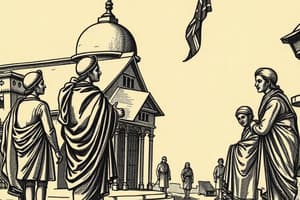Podcast
Questions and Answers
Under which Act was the Governor-General of Bengal made the Governor-General of India?
Under which Act was the Governor-General of Bengal made the Governor-General of India?
- Indian Councils Act, 1909
- Regulating Act, 1773
- Government of India Act, 1858
- Charter Act, 1833 (correct)
Which act allowed Indians to participate in the legislative process for the first time?
Which act allowed Indians to participate in the legislative process for the first time?
- Indian Independence Act, 1947
- Government of India Act, 1919 (correct)
- Government of India Act, 1935
- Indian Councils Act, 1861
The dual system of government in Bengal was abolished by which of the following?
The dual system of government in Bengal was abolished by which of the following?
- Government of India Act, 1858
- Regulating Act, 1773 (correct)
- Warren Hastings
- Pitt’s India Act, 1784
Which act was passed after the Revolt of 1857, transferring the power from the East India Company to the British Crown?
Which act was passed after the Revolt of 1857, transferring the power from the East India Company to the British Crown?
Who was the law member added to the Governor-General’s Council under the Charter Act of 1833?
Who was the law member added to the Governor-General’s Council under the Charter Act of 1833?
Which of the following acts is associated with the introduction of local self-government in India?
Which of the following acts is associated with the introduction of local self-government in India?
Which Act introduced the principle of ‘responsible government’ in India?
Which Act introduced the principle of ‘responsible government’ in India?
The Charter Act of 1853 was significant because it:
The Charter Act of 1853 was significant because it:
Which act created the office of Secretary of State for India?
Which act created the office of Secretary of State for India?
The Indian Councils Act of 1909 is also known as:
The Indian Councils Act of 1909 is also known as:
Which act marked the first step by the British government to control and regulate the affairs of the East India Company in India?
Which act marked the first step by the British government to control and regulate the affairs of the East India Company in India?
Who was the first Governor-General of Bengal appointed under the Regulating Act of 1773?
Who was the first Governor-General of Bengal appointed under the Regulating Act of 1773?
The Amending Act of 1781, also known as the Act of Settlement, was passed to rectify the defects of which Act?
The Amending Act of 1781, also known as the Act of Settlement, was passed to rectify the defects of which Act?
Which of the following acts introduced the concept of 'dual government' in India?
Which of the following acts introduced the concept of 'dual government' in India?
The Charter Act of 1833 was significant because it:
The Charter Act of 1833 was significant because it:
Which act is also known as the 'Act for the Good Government of India'?
Which act is also known as the 'Act for the Good Government of India'?
Which of the following Acts initiated the process of decentralization by restoring legislative powers to the Bombay and Madras Presidencies?
Which of the following Acts initiated the process of decentralization by restoring legislative powers to the Bombay and Madras Presidencies?
The Indian Independence Act, 1947, provided for the creation of which two independent dominions?
The Indian Independence Act, 1947, provided for the creation of which two independent dominions?
Study Notes
British Government Control in India
- Regulating Act, 1773: First act to control East India Company; established a regulatory framework.
- Pitt's India Act, 1784: Introduced dual governance; marked further British control.
- Government of India Act, 1858: Transferred power from East India Company to the British Crown following the Revolt of 1857.
Key Officials and Legislation
- Warren Hastings: First Governor-General of Bengal, appointed under the Regulating Act of 1773.
- Lord Macaulay: Law member added to Governor-General’s Council through the Charter Act of 1833.
Significant Acts and Their Impacts
- Amending Act of 1781: Known as Act of Settlement; corrected shortcomings of the Regulating Act, 1773.
- Charter Act, 1833: Ended East India Company's trade monopoly; segregated legislative and executive powers within the Governor-General’s Council.
- Indian Councils Act, 1861: Introduced local self-government and allowed some Indian participation in governance.
Advances in Governance
- Government of India Act, 1919: Established a dyarchy in provinces; reflected a move toward responsible government.
- Government of India Act, 1935: Implemented federal structure; formalized separate electorates for Muslims.
Judicial Developments
- Supreme Court at Calcutta: Established under the Regulating Act, 1773, marking a significant judicial reform.
Indian Independence and Its Aftermath
- Indian Independence Act, 1947: Established two independent dominions, India and Pakistan, signaling the end of colonial rule.
Key Terminology
- Dual Government: Concept introduced by Pitt’s India Act, 1784, which allowed for a dual structure of governance in British India.
- Responsible Government: Introduced through the Government of India Act, 1935, which aimed to make local governance more accountable.
Local Governance Reforms
- Vernacular Press Act of 1878: Enforced by Lord Lytton, aimed to control Indian-language publications, reflecting colonial anxieties over nationalist sentiments.
Legislative Evolution
- Charter Act, 1853: Key milestone in civil service reform; introduced open competition for civil services, expanding opportunities for Indians.
Modification of Governance Structures
- Indian Councils Act, 1909 (Minto-Morley Reforms): Expanded legislative councils and provided for limited Indian representation, setting the stage for further reforms.
Contextual Note
- The various acts reflect a progression from mere commercial regulation of the East India Company to comprehensive administrative control and governance reforms aimed at addressing the growing demands for Indian participation in governance and the eventual path towards independence.
Studying That Suits You
Use AI to generate personalized quizzes and flashcards to suit your learning preferences.
Description
Test your knowledge of the acts and key figures that shaped the British regulation of the East India Company in India. This quiz covers essential historical legislation such as the Regulating Act of 1773 and the Pitt's India Act of 1784. It's perfect for history enthusiasts looking to deepen their understanding of colonial governance.




